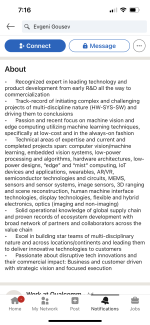Ewwu! That doesn't end well ...
You are using an out of date browser. It may not display this or other websites correctly.
You should upgrade or use an alternative browser.
You should upgrade or use an alternative browser.
BRN Discussion Ongoing
- Thread starter TechGirl
- Start date
mrgds
Regular
oh, he absolutely was .I still think he is talking about me lol
Hang on, you might want this device in a phone, or an even smaller sensor at the edge, so you need a way to digitize the audio. You can't afford the cost or performance to convert it to a wav or an mp3, so what file structure or codec do you choose that will best suit this security application?I admit to only reading the abstract but that makes me believe this is rebranding of an existing technology: encrypted Pulse Code Modulation—the standard way of all computers to currently securely transmit audio. The ONLY inventive part being the involvement of a neural network used to encode and decode based off an acoustic signature ( and then still, a signature used to distort a spatio-temporal distribution—aka encryption of PCM). The learning part is a bit novel, and more possible with a neural network, but then what will stop a hostile intercept entity from using the same “embodiment” and learning also?
As with MANY patents I am amazed that this was able to be patented.
Sometimes I think patents exist just to keep the patent office in a job.
Create the best one and patent it for sure.
At the end of the day it probs costs $10Mil to obtain any old patent.
TheFunkMachine
seeds have the potential to become trees.
Are you back FF or just saying hello? Because we need you in here lolThere has been much said about the failure of Brainchip Inc employees to buy Brainchip shares on market most of which is either uniformed or deliberately dishonest.
Since 2020 the company has stated in writing and in oral presentations that it has multiple NDAs some of which have been disclosed now such as NASA, Ford, Valeo, Mercedes Benz, Renesas and Mega Chips. In more recent months the company has also disclosed a number of commercial partnerships with the likes of ARM, Edge Impulse, Prophesee, SiFive, Intellisense, ISL (formerly an NDA EAP), US Airforce Research and Nviso.
Since 2020 retail shareholders have begged the company for more information about these NDAs including the non disclosed 10 or so others and these commercial partnerships and have been advised on multiple occasions that these companies as a result of their NDAs and desires to keep secret what they are intending or hoping to do with AKIDA have insisted that Brainchip and employees keep these details secret.
Indeed Rob Telson in a very popular interview much cited here stated that NASA was looking at AKIDA for vision and other things that they were prohibited from talking about.
More recently it has been cited time and time again on these threads since the May, 2022 AGM that the CEO Sean Hehir stated that the only way retail shareholders will be able to follow the progress of the company as a result of customer demands for secrecy is to look to the 4C’s.
In keeping these details secret ALL OF BRAINCHIP’S BOARD AND KEY MANAGEMENT PERSONNEL (and likely most employees) will be in possession of information that you the retail shareholder do not have, and if you did have this information to the exclusion of the market generally, it would permit you to trade either for profit or to minimise your future losses, and in so doing you would be insider trading.
The rules that apply to you as a retail investor not to engage in insider trading if you stumbled across this information apply to ALL OF BRAINCHIP’S BOARD AND KEY MANAGEMENT PERSONNEL (and likely most employees) at Brainchip.
It is of course convenient for some here to ignore the fact that Tony Dawe was prior to joining Brainchip Inc a retail shareholder of Brainchip Inc and continues to hold his shares and has lamented to various shareholders in his written communications that he is prohibited from buying shares on market in Brainchip Inc.
Why would this be so? Perhaps using a little imagination you might work out that working closely as he does with Peter van der Made at the Perth Innovation Centre Tony Dawe has insider knowledge of patents and technological developments around cortical columns for example which you as an ordinary retail shareholder are not privy.
I have posted about this in the past and the law and how it applies to Insider Trading which is straight forward and easy to understand and so I am left to ponder the motives of some who I know would have read my previous posts on this subject yet who are raising this subject today.
Of course I note that one of these posters has claimed over a number of weeks a desire to purchase more Brainchip Inc shares when funds become available and yet this poster is constantly posting negative views supported by nothing other than anxiety but has now moved to posting completely misleading opinions about the failure of Brainchip’s Board and Key Management to buy shares on market when this poster must know they are prohibited from doing so by law.
Unless this poster does not believe any of the company statements regarding the desire of the undisclosed NDA’s and those who have been disclosed to keep secret what is being done with Brainchip’s AKIDA technology then the following clause from the ASX Guidance Note No.27 covering Insider Trading is the complete answer as inconvenient as it is for them and those who are trying to manipulate other retail and drive down the share price to their advantage. Perhaps they are not trying to do this and just like to raise fear and doubt in others for kicks or are complete fools who have absolutely no idea and are prepared to say whatever rubbish comes into their heads. It is not for me to judge.
4.6. A cautionary note about the application of insider trading laws
It should be noted that the fact a trade occurs during a permitted trading window, or outside a black-out period, under an entity’s trading policy does not preclude it from breaching insider trading laws, if it is undertaken or procured by someone in possession of inside information at the time. ASX would therefore recommend that an entity include a warning in its trading policy that a person who possesses inside information about an entity’s securities is generally prohibited from trading in those securities under insider trading laws and that this applies even where the trade occurs within a permitted trading window, or outside a black-out period, specified in the policy.39
My opinion only but based on publicly available law and FACTS.
Kind regards
Fact Finder
Twing
Akida’s gambit
Hi FF,There has been much said about the failure of Brainchip Inc employees to buy Brainchip shares on market most of which is either uniformed or deliberately dishonest.
Since 2020 the company has stated in writing and in oral presentations that it has multiple NDAs some of which have been disclosed now such as NASA, Ford, Valeo, Mercedes Benz, Renesas and Mega Chips. In more recent months the company has also disclosed a number of commercial partnerships with the likes of ARM, Edge Impulse, Prophesee, SiFive, Intellisense, ISL (formerly an NDA EAP), US Airforce Research and Nviso.
Since 2020 retail shareholders have begged the company for more information about these NDAs including the non disclosed 10 or so others and these commercial partnerships and have been advised on multiple occasions that these companies as a result of their NDAs and desires to keep secret what they are intending or hoping to do with AKIDA have insisted that Brainchip and employees keep these details secret.
Indeed Rob Telson in a very popular interview much cited here stated that NASA was looking at AKIDA for vision and other things that they were prohibited from talking about.
More recently it has been cited time and time again on these threads since the May, 2022 AGM that the CEO Sean Hehir stated that the only way retail shareholders will be able to follow the progress of the company as a result of customer demands for secrecy is to look to the 4C’s.
In keeping these details secret ALL OF BRAINCHIP’S BOARD AND KEY MANAGEMENT PERSONNEL (and likely most employees) will be in possession of information that you the retail shareholder do not have, and if you did have this information to the exclusion of the market generally, it would permit you to trade either for profit or to minimise your future losses, and in so doing you would be insider trading.
The rules that apply to you as a retail investor not to engage in insider trading if you stumbled across this information apply to ALL OF BRAINCHIP’S BOARD AND KEY MANAGEMENT PERSONNEL (and likely most employees) at Brainchip.
It is of course convenient for some here to ignore the fact that Tony Dawe was prior to joining Brainchip Inc a retail shareholder of Brainchip Inc and continues to hold his shares and has lamented to various shareholders in his written communications that he is prohibited from buying shares on market in Brainchip Inc.
Why would this be so? Perhaps using a little imagination you might work out that working closely as he does with Peter van der Made at the Perth Innovation Centre Tony Dawe has insider knowledge of patents and technological developments around cortical columns for example which you as an ordinary retail shareholder are not privy.
I have posted about this in the past and the law and how it applies to Insider Trading which is straight forward and easy to understand and so I am left to ponder the motives of some who I know would have read my previous posts on this subject yet who are raising this subject today.
Of course I note that one of these posters has claimed over a number of weeks a desire to purchase more Brainchip Inc shares when funds become available and yet this poster is constantly posting negative views supported by nothing other than anxiety but has now moved to posting completely misleading opinions about the failure of Brainchip’s Board and Key Management to buy shares on market when this poster must know they are prohibited from doing so by law.
Unless this poster does not believe any of the company statements regarding the desire of the undisclosed NDA’s and those who have been disclosed to keep secret what is being done with Brainchip’s AKIDA technology then the following clause from the ASX Guidance Note No.27 covering Insider Trading is the complete answer as inconvenient as it is for them and those who are trying to manipulate other retail and drive down the share price to their advantage. Perhaps they are not trying to do this and just like to raise fear and doubt in others for kicks or are complete fools who have absolutely no idea and are prepared to say whatever rubbish comes into their heads. It is not for me to judge.
4.6. A cautionary note about the application of insider trading laws
It should be noted that the fact a trade occurs during a permitted trading window, or outside a black-out period, under an entity’s trading policy does not preclude it from breaching insider trading laws, if it is undertaken or procured by someone in possession of inside information at the time. ASX would therefore recommend that an entity include a warning in its trading policy that a person who possesses inside information about an entity’s securities is generally prohibited from trading in those securities under insider trading laws and that this applies even where the trade occurs within a permitted trading window, or outside a black-out period, specified in the policy.39
My opinion only but based on publicly available law and FACTS.
Kind regards
Fact Finder
I for one greatly appreciate your very factual response in order to correct the slightly wayward direction this forum was beginning to take with regard to our enormously skilled & select team. Having been in a similar position myself in the past where as much as you'd like to invest in the company you can't on the open market, a very frustrating position to be in.
I also appreciate the effort made in venturing back to this forum to make the point.
Regards Twing.
TheFunkMachine
seeds have the potential to become trees.
I decided to comment on a TinyML post on linked in. A senior director from Qualcomm liked both my posts, one talking about Akida, and one linking to the edge impulse seminar. Probably nothing, but also kind of random like?
Attachments
Sirod69
bavarian girl ;-)
Rob Telson gefällt das
Dr. Randhir Thakur• 3.+President, Intel Foundry Services11 Std. • vor 11 Stunden
Folgen
Software is the soul of the machine, and semiconductors run the world. Today, during a keynote at Hot Chips Symposium, Intel CEO Pat Gelsinger introduced a new foundry model for a new era of chipmaking. The Systems Foundry model is an effort to reboot the current foundry approach that enabled an explosion of ecosystem innovation at the wafer level.
The model is built from four components: the traditional wafer aspect – still driven by Moore's Law – plus packaging, chiplet standards and software. Advanced packaging allows us to build more complex systems out of smaller functions to deliver customized heterogenous solutions. Chiplet standards enable a platform transformation around these advanced packaging technologies. And software ties it all together; to bring the systems approach to life, we must lead with a software-first mindset at every layer.
As the industry transitions from a “system on chip” to a “system of chips,” we need to optimize everything from the system and software architecture to how we do manufacturing and test. Intel Foundry Services (IFS) is leading the Systems Foundry transformation by offering secure supply, open platforms, and composable solutions through chips, packaging, and system software. A Systems Foundry approach will facilitate holistic solutions to overcome fundamental limits and meet the industry's insatiable demand for more semiconductors.

Slymeat
Move on, nothing to see.
So now Mercedes are talking about axial flux motors in their AMG.Wow @Diogenese, you just gave me a blast from the past memory—that is basically what I said in my 1985 thesis presentation on axial flux motors. I foresaw a time when each wheel would contain a separately controlled axial flux motor providing all of the power, regenerative braking, and steering without the need to direct the wheels as much.
It’s only 37 years after I proposed in my thesis that they would suit being used in each wheel of a car.
Mercedes are ascribing its “invention” to an Oxford PhD student of today. He has proposed just one drive for the entire vehicle.
Maybe I should patent it and use my thesis as preceeding research. It’s a pity that my university owns the rights to my thesis though.
But to be fair, my thesis was all about sorting out the excessive 3rd and 5th order harmonics in the drive, using it in a car was just one example I proposed of its use after proving the harmonics could be controlled with judicious placement of a sinusoidal winding layout and many poles.
One day I might just get to see a car with an axial flux motor in each wheel. It will be super high performance.
Welcome back FF. @Fact Finder thanks for keep us calm and together.
D
Deleted member 118
Guest
oh, he absolutely was .
Won’t be the 1st or last person I’ll ever upset, but maybe his forgotten to take his meds as someone calling me a down ramper lol. I not even going to bother showing my commsec account as I’ve nothing to show yet as I’m still holding on to get in lower.
GStocks123
Regular
Has this been posted before? U.S Navy


(NEPTUNE) Threat Detection & Tracking for Vehicle Gunners - Dimensions
ABSTRACT: Vehicle gunners need to improve the speed and reliability of threat detection and targetacquisition/engagement. Lidar specifically designed for A) long-range, B) rapid, accurate, andflexible beam-steering, C) detection using laser pulse shapes, D) complementing cameraimaging, E)...
app.dimensions.ai
GStocks123
Regular
Taproot
Regular
Yes, but never get tired of ready that abstractHas this been posted before? U.S Navy

(NEPTUNE) Threat Detection & Tracking for Vehicle Gunners - Dimensions
ABSTRACT: Vehicle gunners need to improve the speed and reliability of threat detection and targetacquisition/engagement. Lidar specifically designed for A) long-range, B) rapid, accurate, andflexible beam-steering, C) detection using laser pulse shapes, D) complementing cameraimaging, E)...app.dimensions.ai
This new trillion-dollar sector of the economy will be based onseveral key technologies which are coming to fruition at the same time: A) algorithmicdevelopments in artificial intelligence and machine learning, B) AI chips which are afundamental change in the nature of computing hardware, shifting from von Neumannarchitecture to distributed memory and computation mimicking neural structures of the brain (seefor example research and commercial projects in neuromorphic computing, Brainchips Akida,Intels Loihi, or Graphcore), C) 3D Sensors lidars, radars, and ultrasonic sensors can produce3D point clouds (azimuthal, elevation, and range), providing a new basis for precisionpositioning, object detection, classification, and tracking, and D) the electrification andoptimized coordination of vehicle fleets.
Teach22
Regular
The only people on this forum who “need” FF here are those who have not done their DD on the stock they hold and/or need to be constantly reassured by others that they have made the correct decision.Are you back FF or just saying hello? Because we need you in here lol
At this stage we don’t know how successful BRN will be in the future. The amount of products that appear on the forum tells us that there are others in this space who currently have products on the market.
If you bought into BRN solely because someone told you it was going to be a $500 share in the future then you probably “need” FF to return, however, if you bought in after doing your research then perhaps remind yourself of that research.
Just my opinion.
Techinvestor17
Regular
The first one in the new thread you set up for the patent application that’s due to be issued.which one
DollazAndSense
Regular
Absolutely.The only people on this forum who “need” FF here are those who have not done their DD on the stock they hold and/or need to be constantly reassured by others that they have made the correct decision.
At this stage we don’t know how successful BRN will be in the future. The amount of products that appear on the forum tells us that there are others in this space who currently have products on the market.
If you bought into BRN solely because someone told you it was going to be a $500 share in the future then you probably “need” FF to return, however, if you bought in after doing your research then perhaps remind yourself of that research.
Just my opinion.
It is quite unfair of the people who want FF to be around as a means to strengthen their conviction in the company. No wonder FF left - that is a big burden to have lumped on you. Feeling a certain responsibility for someone's investment decisions when he always promoted heavily to DYOR.
TBH not many companies can do what Akida can do, and do it where it counts - at the edge. I can't think of any.The only people on this forum who “need” FF here are those who have not done their DD on the stock they hold and/or need to be constantly reassured by others that they have made the correct decision.
At this stage we don’t know how successful BRN will be in the future. The amount of products that appear on the forum tells us that there are others in this space who currently have products on the market.
If you bought into BRN solely because someone told you it was going to be a $500 share in the future then you probably “need” FF to return, however, if you bought in after doing your research then perhaps remind yourself of that research.
Just my opinion.
There are a dozen companies that might simulate/emulate some of what it does by using expensive and power hungry number cruncher chips, or by not doing anything at all really.
You know an automatic door isn't AI, right?
Last edited:
Similar threads
- Replies
- 0
- Views
- 4K
- Replies
- 7
- Views
- 5K
- Replies
- 0
- Views
- 3K




